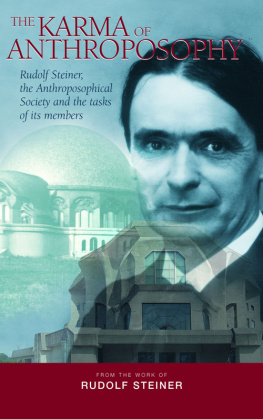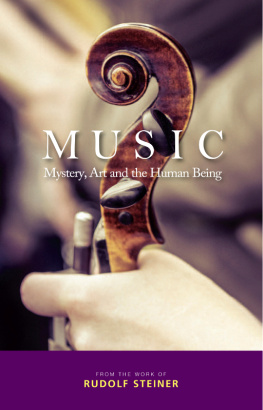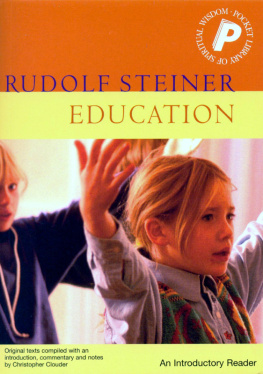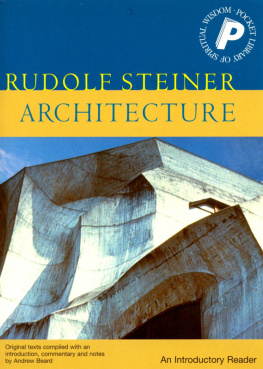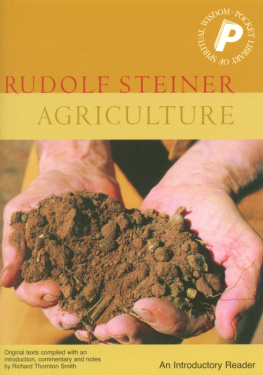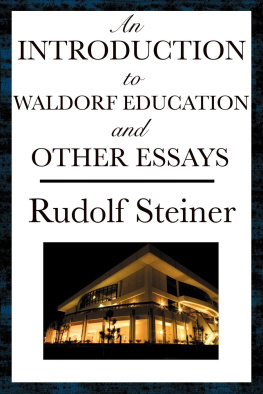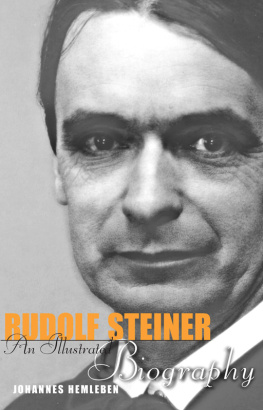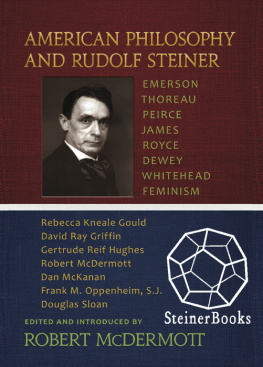A G UIDE TO F URTHER R EADING
L ECTURES AND W RITINGS BY R UDOLF S TEINER
Agriculture Course: The Birth of the Biodynamic Method , Rudolf Steiner Press, 2005. These are the original lectures behind this dynamic agricultural method.
Anthroposophical Leading Thoughts: Anthroposophy as a Path of Knowledge: The Michael Letters , Rudolf Steiner Press, 1998. During the time that Rudolf Steiner wrote his autobiographical installments, he also wrote weekly letters (from February 1924 until December 1924) that went out to members of the Anthroposophical Society. He crystallized the path of Anthroposophy into concentrated summaries called leading thoughts. He hoped that they would be studied and thus support and stimulate the society. In August, 1924, Steiner introduced the Michael impulse to transform modern human consciousness. These thoughts are Rudolf Steiners final expression of Anthroposophy and its future.
The Anthroposophic Movement , Rudolf Steiner Press, London, 1993. These lectures provide an encompassing overview of how the anthroposophic movement came into existence and what it means for today and in the future.
Anthroposophy (A Fragment) , SteinerBooks, 2006. Steiners written work (never fully completed to his satisfaction), outlining a new methodology for the study of human nature. It was written in 1910, when Steiner was working out his ideas on psychology and physiology in relation to spirit. (Those lectures are in A Psychology of Body, Soul, & Spirit.) These ideas, though somewhat difficult, constitute the steps he took toward a truly cognitive psychology.
Art as Spiritual Activity: Rudolf Steiners Contribution to the Visual Arts , edited and introduced by Michael Howard, Anthroposophic Press, Great Barrington, MA, 1998. This book provides an excellent introduction to Steiners spiritual approach to the arts, particularly architecture and sculpture. The comprehensive introduction and ten lectures include numerous illustrations.
Autobiography: Chapters in the Course of My Life, 18611907 , SteinerBooks, 2006. Rudolf Steiner seldom spoke of himself in a personal way, but here he offers a glimpse into some of the most intimate aspects of his inner life, his personal relationships, and significant events that helped to shape the philosopher, seer, and teacher he became.
The Bhagavad Gita and the West: The Esoteric Meaning of the Bhagavad Gita and Its Relation to the Letters of St. Paul , SteinerBooks 2008. This book presents Steiners profound engagement with Hindu thought and, above all, the Krishna in the Bhagavad Gita as they illuminate Western Christian esotericism.
Christianity as Mystical Fact , Anthroposophic Press, Great Barrington, MA, 1997, translated and introduced by Andrew Welburn with an afterword by Reverend Michael Debus of The Christian Community. This book was edited and reworked by Steiner from a series of 25 lectures given at the Theosophical Library in Berlin (October 5, 1901March 22, 1902). Steiner describes how the ancient mysteries foresaw and led up to the Mystery of Golgotha as the turning point of world history.
The Christian Mystery , Anthroposophic Press, 1998. These early lectures from 1905 to 1908 provide a clear picture of Steiners esoteric Christianity. He discusses many aspects of the Christian path, including prayer, the Gospels, the Mystery of Golgotha, the esoteric meaning of the mass, and so on.
The Christmas Conference for the Foundation of the General Anthroposophical Society, 1923/1924 , Anthroposophic Press, 1990. Contains the documents, lectures, and other material from the conference at which Rudolf Steiner reestablished the Anthroposophical Society.
Calendar 19121913: Facsimile Edition of the Original Book Containing the Calendar created by Rudolf Steiner for the Year 19121913 , SteinerBooks, 2003. This edition contains the Calendar of the Soul, as well as reproductions of the esoteric seals developed by Rudolf Steiner for contemplation.
Cosmic Memory: Prehistory of Earth and Man , Garber Communications, Blauvelt, NY, 1987. Written between 1904 and 1908, this book evolved from Steiners reading of the akashic chronicle, the etheric record of cosmic, historic events. It presents a unique imagination of the evolution of Earth and humanity.
Education for Special Needs: The Curative Education Course , Rudolf Steiner Press, 1998. These lectures are the culmination of Steiners methods for educating those who are developmentally disabled. The seed for this lecture course was in his tutoring of Richard Specht, described in part 1 of the present volume.
First Steps in Inner Development , Anthroposophic Press, 1999. This is a collection of lectures and works by Steiner that specifically describe the anthroposophic approach to spiritual practice and the requirements for its success. These are very practical and direct instructions for inner development.
The Foundations of Human Experience , Anthroposophic Press, 1996. Here Steiner laid the groundwork for the understanding of the human being from the aspects of soul, spirit, and body, the basis of Waldorf education.
Friedrich Nietzsche: Fighter for Freedom . Spiritual Science Library, Blauvelt, NY, 1985. Steiner characterizes Nietzsche as a profound truth seeker caught in the materialism of his time.
From the History and Contents of the First Section of the Esoteric School, 19041914 , SteinerBooks, 2006. Chronicles the development of Steiners esoteric teaching described in the final section of the Autobiography. It also records the events surrounding the formation of the Anthroposophic Society from the German Section of the Theosophical Society.
Goethes Theory of Knowledge: An Outline of the Epistemology of His Worldview , SteinerBooks, 2008. Here, Steiner first outlined his understanding of Goethes epistemology during the 1880s, which became a foundation for his future teaching of Anthroposophy.
The Gospel of St. John , Anthroposophic Press, 1984. Some of Steiners most important lectures on Christianity and Johns Gospel.
Guidance in Esoteric Training: From the Esoteric School , Rudolf Steiner Press, 1994. Contains exercises, meditations, and practices for spiritual development as given by Steiner to his students in the Esoteric School between 1904 and 1914.
The Healing Process: Spirit, Nature, and Our Bodies , Anthroposophic Press, 2000. Steiner discusses fundamental principles of anthroposophically extended medicine. Some of his most remarkable insights on medicine are contained in this volume.
How to Know Higher Worlds: A Modern Path of Initiation , Anthroposophic Press, 1994. Steiner wrote this work to lay out the conditions and methods of spiritual science, methods that, when worked with diligently, lead to a greater spiritual capacity for knowledge.
Introducing Anthroposophical Medicine , Anthroposophic Press, 1999. These lectures were given to doctors during a seminar in 1920. This book gives the essentials of the anthroposophic approach to illness and healing methods.
Intuitive Thinking as a Spiritual Path: A Philosophy of Freedom , Anthroposophic Press, 1995. Published in 1894, while Steiner was editing Goethes natural scientific writings. As the subtitle to his Philosophy of Freedom, Steiner chose Results of Soul Observation Arrived at by the Scientific Method. His basic thesis is that we need not accept the self-imposed limitation of knowledge gained through sense observation, intellectual analysis, and interpretation. Thinking, as the instrument of human cognition, can be extended through an individuals inner activity to become the primary instrument for knowledge that goes beyond the limitations of sense perception, opening the path to spiritual cognition.


